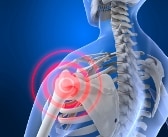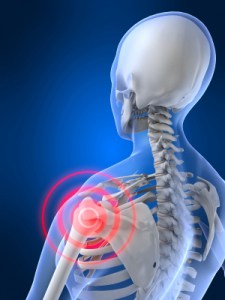What is frozen shoulder?
Frozen shoulder (also known as adhesive capsulitis) is a three stage condition in which the shoulder becomes completely or partially unmovable. It is one of the most painful conditions that can affect the shoulder. While a frozen shoulder may present with symptoms similar to that of other conditions which affect the shoulder it has a particularly distinct set of symptoms which result in severe pain, loss of movement and eventually stiffness.
What causes frozen shoulder?
It is not fully understood why frozen shoulder occurs and it is not always possible to identify the cause of frozen shoulder. Frozen shoulder occurs when there is thickening and swelling of the flexible tissue (capsule) surrounding your shoulder joint. This thickening and swelling causes a reduction of space for your upper arm bone in the joint which makes any movement stiff and painful. However, there are certain predisposing factors which lead to an increased chance of developing frozen shoulder.
- People with diabetes have an increase risk of developing frozen shoulder.
- Frozen shoulder has an increased likelihood of developing in people who have previously suffered a shoulder injury. This can partly be attributed to people keeping their shoulder still during their recovery which can lead to the shoulder tightening up due to inactivity.
- Age and gender can be an influencing factor as women are twice as likely to develop frozen shoulder in comparison to men.
- Individuals who develop inflammatory shoulder.
- People with autoimmune diseases
What are the symptoms of frozen shoulder?
- A dull or aching pain in the affected shoulder.
- Stiffness around the shoulder joint.
- Restricted range of movement in the affected shoulder.
- Difficulty performing daily activities such as washing, dressing (in particular when trying to put on a bra) and driving.
Stages of Frozen Shoulder
Freezing Phase: This phase typically lasts between 10 to 36 weeks. There will a spontaneous onset of shoulder pain which is often severe and disrupts sleep. To avoid the pain, people often rest the arm when they realise pain does not occur upon movement. This period of stillness for the arm leads to a stiffening of the shoulder joint.
Frozen Phase: Pain is often followed by stiffening at the shoulder. This phase may last 4 -12 months. People will often lose movement in specific planes such as rotation of the shoulder and when trying to raise the shoulder above the head. This stiffness results from lack of movement at the shoulder due to the pain which occurred in the freezing phase.
Thawing Phase: The final phase is described as thawing and is characterised by a gradual recovery of of movement. The thawing phase will last an average of 5-26 months and is directly related to the length of time the shoulder was initially painful during the freezing stage.
How can physiotherapy help?
Physiotherapy is highly recommended in the management of frozen shoulder. Physiotherapy helps to maintain and increase the range of movement that is lost due to frozen shoulder. Treatment will vary dependent on the phase the affected shoulder is in.


